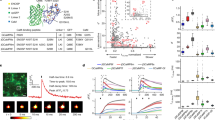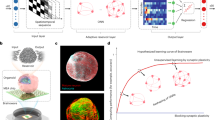Abstract
The cellular element of the aorta is largely smooth muscle; yet this organ has long been regarded as a passive elastic tube1–4, without regard for the possible function of its smooth muscle cells. The isolated rabbit aorta became popular as a convenient smooth muscle preparation5, and much has been learned about its cellular physiology, but unfortunately the functional role of this tissue was lost on its excision. Like many mammalian arterial preparations, the isolated aorta either fails to show spontaneous electrical or mechanical activity, or shows activity of a much slower frequency than the rhythmic activity of the heart6,7, thus obscuring any possible relationship with the pulsatile activity of the heart. However, contractions are elicited from the isolated aorta on stimulation with various neural and hormonal agents5–10. In effect, the aortic smooth muscle has been classified as multiunit, which suggests that physiological activation may be neurogenic11. Thus, removal of the muscle from the body may result in disruption of the neural connections which function in normal activation of contraction. We show here that when recordings of aortic tension are made in vivo, rhythmic contractions are observed. Evidence is presented which indicates that the contractions are neurogenic in origin and exhibit a precise phasing pattern with the pulse wave.
This is a preview of subscription content, access via your institution
Access options
Subscribe to this journal
Receive 51 print issues and online access
$199.00 per year
only $3.90 per issue
Buy this article
- Purchase on Springer Link
- Instant access to full article PDF
Prices may be subject to local taxes which are calculated during checkout
Similar content being viewed by others
References
Bazett, H. C. Am. J. Physiol. 70, 550–585 (1924).
Maltby, A. B. & Wigers, C. J. Am. J. Physiol. 100, 604–613 (1932).
Hamilton, W. F. & Dow, P. Am. J. Physiol. 125, 48–59 (1939).
Alexander, R. S. Fedn Proc. 11, 738–749 (1952).
Furchgott, R. F. & Bhadrakom, S. J. Pharmac. exp. Theor. 108, 129–143 (1953).
Biamino, G. & Kruckenberg, P. Am. J. Physiol. 217, 376–352 (1969).
Altura, B. M. & Altura, B. T. Microvascular Res. 7, 145–155 (1974).
Furchgott, R. F., Ehrreich, S. J. & Greenblatt, E. J. gen. Physiol. 44, 499–519 (1961).
van Breemen, C. et al. Phil. Trans. R. Soc. B265, 57–71 (1973).
Deth, R. & van Breemen, C. J. Membrane Biol. 40, 363–380 (1977).
Fischer, E. Physiol. Rev. 24, 467–490 (1944).
Dow, P. & Hamilton, W. F. Am. J. Physiol. 125, 60–65 (1939).
Mountcastle, V. B. (ed.) Medical Physiology. Vol. 1, 13th edn (Mosby, St Louis, 1974).
Ganong, W. F. Review of Medical Physiology. 2nd edn (Lange Medical, Los Altos, 1969).
Tomita, T. Prog. Biophys. molec. Biol. 30, 185–202 (1975).
Connor, J. A., Mangel, A. M. & Nelson, B. Am. J. Physiol. 237, C237–C246 (1979).
Boucek, R. J., Takashita, R. & Fojaco, R. Am. J. Anat. 114, 273–282 (1964).
Prokop, E. K., Palmer, R. F. & Wheat, M. W. Circulation Res. 27, 121–127 (1970).
Author information
Authors and Affiliations
Rights and permissions
About this article
Cite this article
Mangel, A., Fahim, M. & van Breemen, C. Rhythmic contractile activity of the in vivo rabbit aorta. Nature 289, 692–694 (1981). https://doi.org/10.1038/289692a0
Received:
Accepted:
Issue Date:
DOI: https://doi.org/10.1038/289692a0
This article is cited by
-
General features of electrical and mechanical properties of smooth muscle cells in the guinea-pig abdominal aorta
Pfl�gers Archiv European Journal of Physiology (1982)
Comments
By submitting a comment you agree to abide by our Terms and Community Guidelines. If you find something abusive or that does not comply with our terms or guidelines please flag it as inappropriate.



